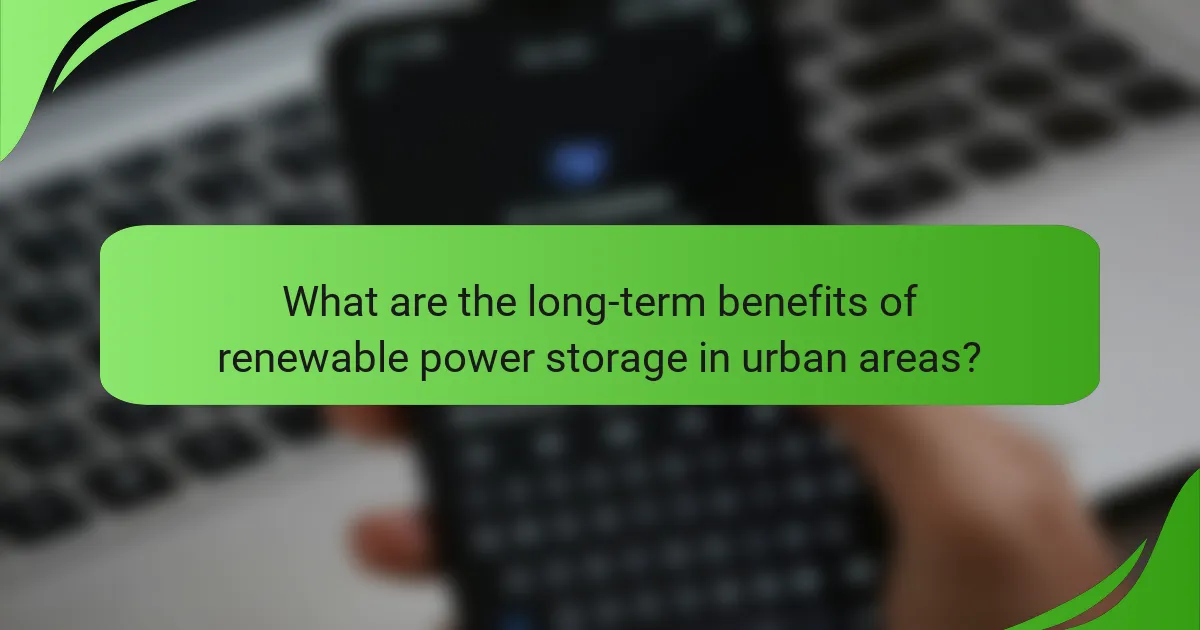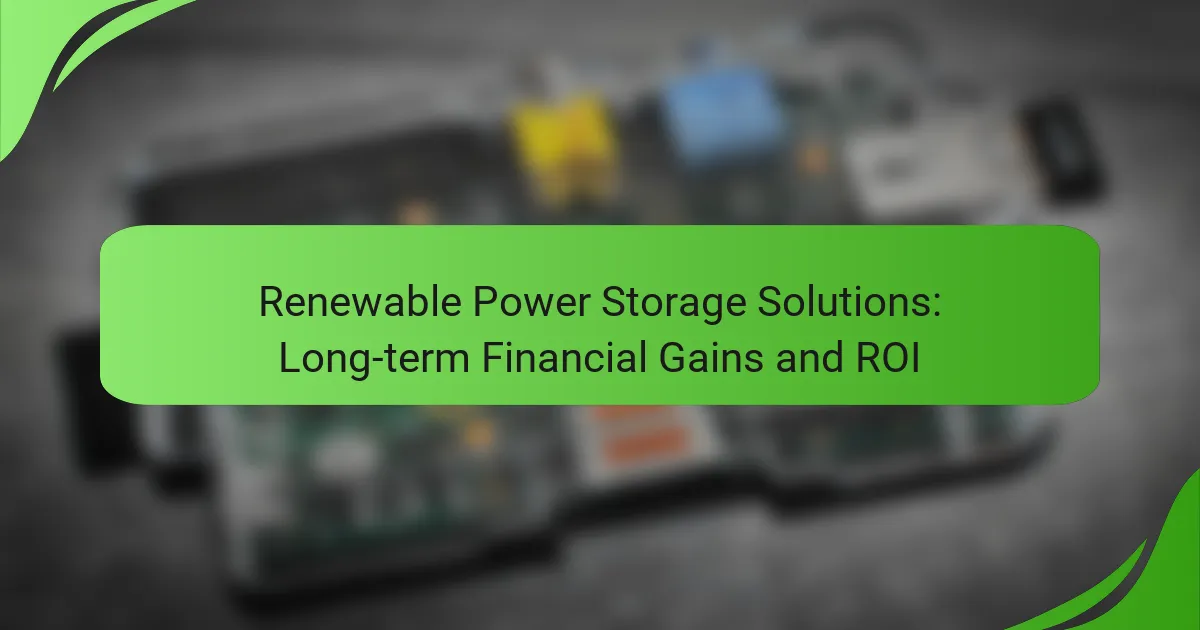Renewable power storage solutions play a crucial role in maximizing financial gains by balancing energy supply and demand while enhancing efficiency. By reducing operational costs and enabling energy arbitrage, these technologies significantly improve the return on investment (ROI) for both businesses and homeowners. Understanding the factors influencing financial performance, such as initial costs and available incentives, is essential for stakeholders aiming to capitalize on long-term benefits.

What are the best renewable power storage solutions for financial gains?
The best renewable power storage solutions for financial gains include technologies that effectively balance supply and demand while maximizing energy efficiency. These systems can significantly reduce operational costs and enhance the return on investment (ROI) for renewable energy projects.
Battery Energy Storage Systems (BESS)
Battery Energy Storage Systems (BESS) are among the most popular solutions for storing renewable energy. They work by charging during periods of low demand and discharging during peak usage, effectively managing energy costs. Lithium-ion batteries are commonly used due to their high efficiency and declining costs.
When considering BESS, evaluate factors such as capacity, discharge duration, and lifecycle costs. Typical installations can range from small residential systems to large utility-scale projects, with costs varying significantly based on scale and technology.
Pumped Hydro Storage
Pumped Hydro Storage utilizes two water reservoirs at different elevations to store energy. During low demand, excess energy is used to pump water uphill; during peak demand, the water is released to generate electricity. This method is highly efficient and can provide large-scale energy storage.
While pumped hydro systems have high initial capital costs, they can offer long-term savings and stability. They are best suited for regions with suitable topography and water availability, making them less common in flat areas.
Compressed Air Energy Storage (CAES)
Compressed Air Energy Storage (CAES) involves compressing air in underground caverns during low demand and releasing it to generate power when needed. This technology can store large amounts of energy and is particularly effective for balancing intermittent renewable sources like wind and solar.
CAES systems require significant infrastructure and geological conditions, which can limit their deployment. However, they can provide substantial financial benefits by reducing reliance on fossil fuels and enhancing grid stability.
Flywheel Energy Storage
Flywheel Energy Storage systems store energy in a rotating mass. When energy is needed, the flywheel’s rotational energy is converted back into electricity. This technology offers rapid response times and high cycle efficiency, making it ideal for short-term energy storage needs.
Flywheels are particularly useful for applications requiring quick bursts of power, such as frequency regulation in the grid. Their relatively low maintenance costs and long lifespan can lead to favorable ROI in the right applications.
Thermal Energy Storage
Thermal Energy Storage systems store energy in the form of heat, typically using materials like water or molten salts. This stored heat can be used to generate electricity or provide heating during peak demand periods. Thermal storage is often integrated with concentrated solar power plants.
Investing in thermal energy storage can lead to significant cost savings by shifting energy use to off-peak times. It is essential to consider the specific thermal characteristics of the storage medium and the intended application to maximize efficiency and financial returns.

How do renewable power storage solutions improve ROI?
Renewable power storage solutions enhance return on investment (ROI) by reducing energy costs, increasing energy independence, and enabling energy arbitrage. These benefits lead to long-term financial gains for both businesses and homeowners.
Cost savings on energy bills
Implementing renewable power storage can significantly lower energy bills by allowing users to store excess energy generated during peak production times. For instance, solar panels can produce more energy during sunny days, which can be stored and used later, reducing reliance on grid electricity during peak hours when rates are higher.
By shifting energy consumption to off-peak times, users can take advantage of lower rates, leading to savings that can range from 20% to 50% on monthly energy costs. This not only improves cash flow but also shortens the payback period for the initial investment in storage solutions.
Increased energy independence
Renewable power storage solutions enhance energy independence by allowing users to generate and store their own energy. This reduces reliance on external energy sources and protects against fluctuating energy prices and potential supply disruptions.
For example, a household with a solar battery system can become less vulnerable to grid outages and price hikes, ensuring a more stable and predictable energy cost structure. This independence can be particularly valuable in regions with unstable energy markets or frequent outages.
Potential for energy arbitrage
Energy arbitrage involves buying electricity at lower rates during off-peak hours and selling or using it during peak hours when prices are higher. Renewable power storage systems enable this strategy by storing energy when it is cheap and discharging it when demand and prices rise.
For businesses, this can mean significant revenue opportunities, especially in deregulated markets where energy prices fluctuate widely. Users can maximize their ROI by strategically managing their energy usage and storage to capitalize on these price differences, potentially increasing profits by 10% to 30% depending on market conditions.

What factors influence the financial performance of storage solutions?
The financial performance of renewable power storage solutions is influenced by several key factors, including initial investment costs, ongoing maintenance and operational expenses, and available government incentives. Understanding these elements can help stakeholders evaluate the potential return on investment (ROI) and long-term financial gains.
Initial investment costs
Initial investment costs for storage solutions can vary significantly based on technology type, capacity, and installation requirements. For instance, lithium-ion battery systems may require a capital outlay ranging from several thousand to tens of thousands of dollars per installed kilowatt-hour (kWh). Evaluating different technologies and their respective costs is crucial for determining the most financially viable option.
Additionally, factors such as site preparation and grid connection can add to the overall expenses. Conducting a thorough cost-benefit analysis before committing to a specific storage solution can help identify the best financial path forward.
Maintenance and operational costs
Maintenance and operational costs are ongoing expenses that can impact the overall financial performance of storage solutions. These costs typically include routine inspections, repairs, and energy management systems. For example, battery systems may incur costs related to monitoring and replacing components every few years, depending on usage and technology.
It’s essential to factor in these costs when calculating ROI, as they can significantly affect profitability over time. Regular maintenance can help extend the lifespan of the system, ultimately leading to better financial outcomes.
Government incentives and rebates
Government incentives and rebates can substantially enhance the financial performance of renewable power storage solutions. Many countries offer tax credits, grants, or rebates to encourage the adoption of energy storage technologies. For instance, in the United States, the Investment Tax Credit (ITC) allows for a percentage of the installation costs to be deducted from federal taxes.
Staying informed about available incentives can help stakeholders maximize their investment. It is advisable to consult local regulations and programs, as these can vary widely by region and may change over time, impacting overall financial calculations.

How to choose the right renewable power storage solution?
Selecting the right renewable power storage solution involves understanding your specific energy needs, local regulations, and the available technology options. A well-informed choice can lead to significant long-term financial gains and improved return on investment (ROI).
Assessing energy needs
Begin by evaluating your energy consumption patterns and peak usage times. This assessment helps determine the capacity required from your storage solution. For residential setups, consider whether you need enough storage to cover daily usage or to support electric vehicle charging and other high-demand appliances.
For businesses, analyze operational hours and seasonal variations in energy demand. A thorough understanding of your energy needs will guide you in selecting a storage solution that optimally balances cost and performance.
Evaluating local regulations
Local regulations can significantly impact the feasibility and cost of renewable power storage solutions. Research any incentives, rebates, or tax credits available for renewable energy investments in your area, as these can enhance ROI.
Additionally, check for zoning laws or building codes that may affect installation. Compliance with local regulations ensures that your storage system is not only effective but also legally sound.
Comparing technology options
There are various technologies available for renewable power storage, including lithium-ion batteries, flow batteries, and pumped hydro storage. Each option has distinct advantages and disadvantages regarding cost, lifespan, efficiency, and environmental impact.
For instance, lithium-ion batteries are popular for their high energy density and efficiency but may have higher upfront costs. In contrast, flow batteries offer longer lifespans and scalability but can be bulkier and less efficient. Compare these technologies based on your specific needs and budget to make an informed decision.

What are the long-term benefits of renewable power storage in urban areas?
Renewable power storage in urban areas offers significant long-term benefits, including enhanced energy reliability, cost savings, and reduced carbon emissions. By integrating storage solutions, cities can better manage energy supply and demand, leading to a more sustainable urban environment.
Cost Savings Over Time
Investing in renewable power storage can lead to substantial cost savings in the long run. By storing excess energy generated during peak production times, urban areas can reduce reliance on expensive peak power sources, lowering overall energy costs. Additionally, many regions offer incentives or rebates for renewable energy installations, further enhancing financial returns.
Increased Energy Independence
Renewable power storage enhances energy independence for urban areas by reducing reliance on external energy sources. This independence can protect cities from fluctuations in energy prices and supply disruptions. For example, cities that invest in battery storage can utilize locally generated solar or wind energy, minimizing the impact of global energy market volatility.
Environmental Impact and Sustainability
Implementing renewable power storage contributes to a significant reduction in greenhouse gas emissions, promoting a cleaner urban environment. By storing and utilizing renewable energy, cities can decrease their carbon footprint and support local climate goals. This transition not only benefits the environment but also enhances public health by reducing air pollution.
Enhanced Grid Stability
Renewable power storage systems improve grid stability by balancing supply and demand. During periods of high energy production, excess energy can be stored and released during peak demand times, preventing grid overloads. This capability is particularly crucial for urban areas with high population density and energy consumption.
Future-Proofing Urban Energy Systems
Investing in renewable power storage is a proactive step toward future-proofing urban energy systems. As technology advances and energy demands evolve, cities that adopt these solutions will be better positioned to integrate new energy sources and technologies. This adaptability can lead to long-term resilience against energy challenges.
